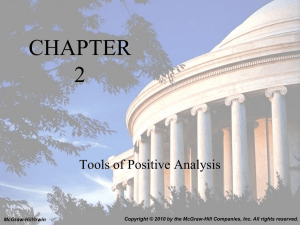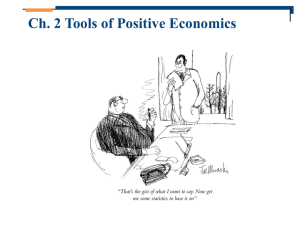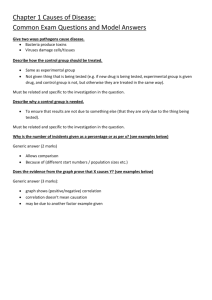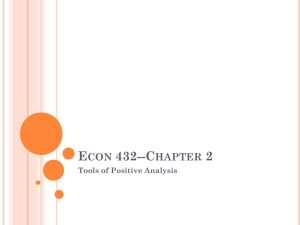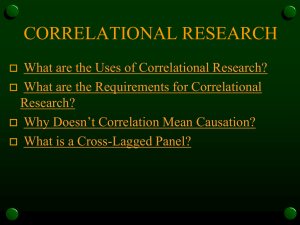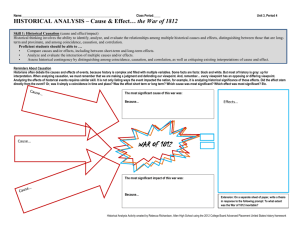Lecture 02, Positive analysis 6ppt
advertisement
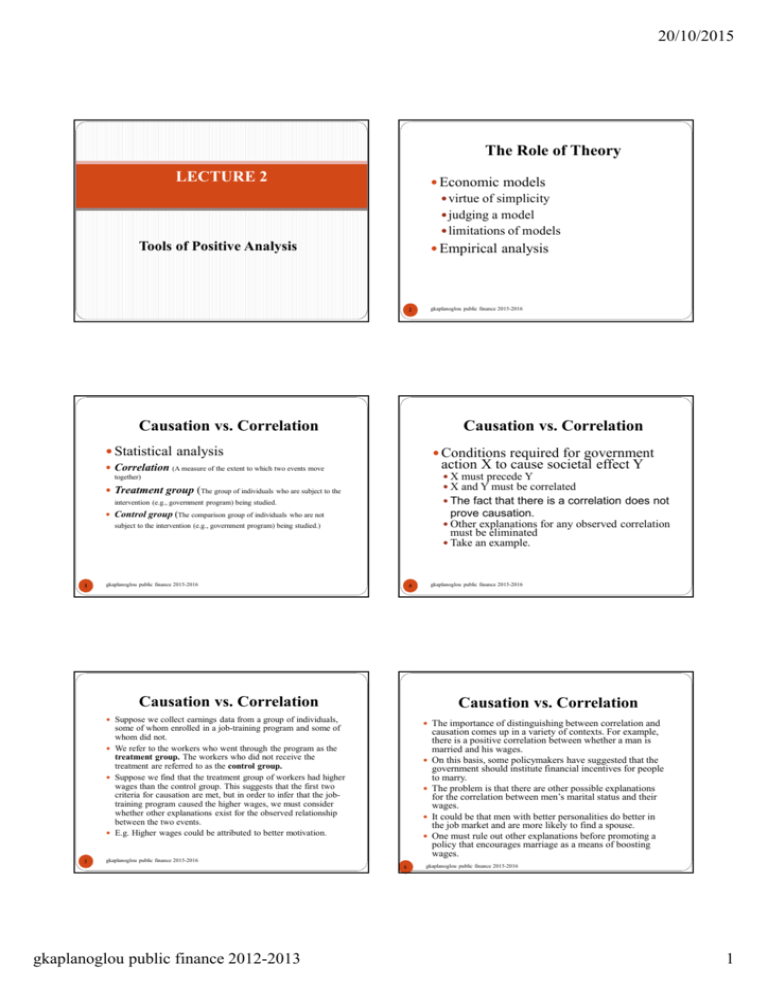
20/10/2015 The Role of Theory LECTURE 2 Economic models virtue of simplicity judging a model limitations of models Tools of Positive Analysis Empirical analysis 2 Causation vs. Correlation Causation vs. Correlation Statistical analysis Conditions required for government action X to cause societal effect Y Correlation (A measure of the extent to which two events move X must precede Y X and Y must be correlated The fact that there is a correlation does not prove causation. Other explanations for any observed correlation must be eliminated Take an example. together) Treatment group (The group of individuals who are subject to the intervention (e.g., government program) being studied. Control group (The comparison group of individuals who are not subject to the intervention (e.g., government program) being studied.) 3 5 gkaplanoglou public finance 2015-2016 gkaplanoglou public finance 2015-2016 4 gkaplanoglou public finance 2015-2016 Causation vs. Correlation Causation vs. Correlation Suppose we collect earnings data from a group of individuals, some of whom enrolled in a job-training program and some of whom did not. We refer to the workers who went through the program as the treatment group. The workers who did not receive the treatment are referred to as the control group. Suppose we find that the treatment group of workers had higher wages than the control group. This suggests that the first two criteria for causation are met, but in order to infer that the jobtraining program caused the higher wages, we must consider whether other explanations exist for the observed relationship between the two events. E.g. Higher wages could be attributed to better motivation. The importance of distinguishing between correlation and causation comes up in a variety of contexts. For example, there is a positive correlation between whether a man is married and his wages. On this basis, some policymakers have suggested that the government should institute financial incentives for people to marry. The problem is that there are other possible explanations for the correlation between men’s marital status and their wages. It could be that men with better personalities do better in the job market and are more likely to find a spouse. One must rule out other explanations before promoting a policy that encourages marriage as a means of boosting wages. gkaplanoglou public finance 2015-2016 6 gkaplanoglou public finance 2012-2013 gkaplanoglou public finance 2015-2016 1 20/10/2015 Biased estimates Experimental Studies In our hypothetical example we saw that the observed relationship between enrolling in the job-training program and wages was due to a third influence—motivation level. The problem is that the characteristics of the control group workers differed from the characteristics of the treatment group workers. As a result, the estimated higher wages for the treatment group relative to the control represented a biased estimate of the true causal impact of the job-training program. A biased estimate is one that conflates the true causal impact with the impact of outside factors. Biased estimates Counterfactual Experimental (or randomized) study 7 gkaplanoglou public finance 2015-2016 8 gkaplanoglou public finance 2015-2016 Counterfactual Experimental (or randomized) study In order to rule out other factors, we would like to know the counterfactual, which is what would have happened to the treatment group had they not received the treatment. Of course, in our job-training example it is impossible to know the true counterfactual because the treatment workers did indeed enroll in the job-training program. However, in a real world is difficult to have counterfactuals, and a good alternative is an In an experimental (or randomized) study, subjects are randomly assigned to either the treatment group or the control group. With random assignment, the people in the control group are not literally the same people as those in the treatment group, but they have similar characteristics on average. Because selection into the treatment group is outside the individual’s control, it is less likely that other factors can lead the investigator to confuse correlation for causation. experimental (or randomized) study 9 gkaplanoglou public finance 2015-2016 10 Conducting an Experimental Study Pitfalls of Experimental Studies In an experimental study of the effect of the jobtraining program on wages, the first step is to randomly assign a sample of workers to either enroll or not enroll in the program. If we start with a small sample of workers, then it is still possible that there will be large differences in the average characteristics of those in the control and treatment groups. However, as our sample size increases, we can expect the characteristics of both groups to be the same on average. 11 gkaplanoglou public finance 2015-2016 gkaplanoglou public finance 2012-2013 gkaplanoglou public finance 2015-2016 Ethical issues Technical problems Response bias Impact of limited duration of experiment Generalization of results to other populations, settings, and related treatments Black box aspect of experiments 12 gkaplanoglou public finance 2015-2016 2 20/10/2015 Conducting an Observational Study Observational Studies • L = α0 + α1wn + α2X1 + … + αnXn + ε • Observational study – empirical study Dependent variable Independent variables Parameters Stochastic error term • Regression analysis – Regression line – Standard error – – – – relying on observed data not obtained from experimental study • Sources of observational data L – Surveys – Administrative records – Governmental data Intercept is α0 • Econometrics – Regression analysis Slope is α1 α0 wn 13 gkaplanoglou public finance 2015-2016 14 Types of Data Pitfalls of Observational Studies Data collected in non-experimental setting Specification issues Cross-sectional data Time-series data Panel data 15 gkaplanoglou public finance 2015-2016 gkaplanoglou public finance 2015-2016 16 Quasi-Experimental Studies gkaplanoglou public finance 2015-2016 Conducting a Quasi-Experimental Study Quasi-experimental study (= natural experiment) – observational study relying on circumstances outside researcher’s control to mimic random assignment Difference-in-difference quasi-experiments (An analysis that compares changes over time in an outcome of the treatment group to changes over the same time period in the outcome of the control group.) Instrumental Variables quasi-experiments (The idea behind instrumental variables analysis is to find some third variable that may have affected entry into the treatment group but in itself is not correlated with the outcome variable.) Regression-Discontinuity Quasi-Experiments (An analysis that relies on a strict cut-off criterion for eligibility of the intervention under study in order to approximate an experimental design.) 17 gkaplanoglou public finance 2015-2016 gkaplanoglou public finance 2012-2013 18 gkaplanoglou public finance 2015-2016 3 20/10/2015 19 Pitfalls of Quasi-Experimental Studies Conclusion Assignment to control and treatment groups may not be random Not applicable to all research questions Generalization of results to other settings and treatments Economic theory plays a crucial role for empirical researchers by framing the research question and helping isolate a set of variables that may influence the particular behavior of interest. Empirical work then tests whether the causal relationship between a policy and an outcome suggested by the theory is consistent with real-world phenomena. gkaplanoglou public finance 2015-2016 gkaplanoglou public finance 2012-2013 20 gkaplanoglou public finance 2015-2016 4
